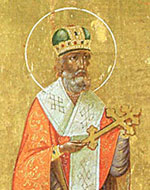Historical Situation at the Time the Laurentian Codex was Written
The Laurentian Codex was produced in the heroic era of the Battle of Kulikovo. This was the era of the liberation of Russia from the Mongol dependency, the period of the national revival and unity of the patriotic forces under the lidership of the Moscow Principality. The text of the manuscript brilliantly reflects the patriotic tendencies of its time, glorifies the cult of a warrior prince - protector, tells the story of heroic events in Russian history. The legendary history offered heroic examples enduring in the memory of people. These inspiring examples , called on the princes to join forces on the eve of the decisive battle with the Horde.
The Laurentian Codex is a key landmark of the rebith of Russian statehood in the turning moment in history. This is evidenced by the role that was intended to this manuscript by its ideological inspirer - Dionysius the Bishop of Suzdal. This role is obvious in the background of the historical processes of that distant time.Mongol domination of Rus territories which was established as a result of the Mongol invasion of the 13th century after the collapse of Kievan Rus' state, contributed to fragmentation of the country. Large portions of the Russian territory were controlled by pagan Lithuania and Catholic Poland, while Russian princes were engaged in constant internecine warfare, incited cleverly by the Tatars. Despite the fact that the Golden Horde steadily weakened in the second half of the fourteenth century, after the assassination of khan Janibek in 1357, due to the internal battles between pretenders to the throne, - the Russian princes were slow to take advantage of it to fight against the Horde. They were still opposed to each other and received from the Horde yarlyks (investitures) granting them principalities.
However, the Russians was rising to fight for freedom. In 1374, Nizhny Novgorod citizens attacked the embassy of Mamai who won the struggle for power in the Horde. Shortly before, Dionysius had been appointed the Bishop of Nizhny Novgorod and Suzdal and must have supported his flock in the anti-Tatar actions. In any case, it was Dionysius at whom the Tatar military chief of the embassy shot an arrow, and only a miracle saved the bishop from the death.
This popular uprising against the Tatar authority showed the patriotic mindset of the Russian people at the time, which accelerated changes taking place in the relations of Russia with the Horde. In the spring of 1377, Dmitry Konstantinovich of Nizhny Novgorod and Suzdal became a member of the raid of the joint armies of Moscow and Nizhny Novgorod against Tatar vassal, Volga Bolgar. It was the first Russian offensive campaign against the Horde since the establishment of the yoke. And it was a success. According to the scribe's inscription, the Laurentian Codex was completed on March 20, 1377, that is, when the Russian army was ready to go to battle. Dionysius of Suzdal blessed the creation of this manuscript to teach the princes by the high heroic example of their ancestors. Through the blessing of Dionysius, the Lavrentian Chronicle was written, inspiring Russia in its bold and decisive action to throw off the Mongol-Tatar Yoke. Just in three years, in 1380, the Prince of Moscow Dmitry, later known as Dmitry of the Don, would seek the blessing of Russia's spiritual leader St. Sergius of Radonezh before the Battle of Kulikovo.
The scribe' inscription does not point out the place of creation of the Laurentian Codex. Most likely, the monk Laurentius worked on the chronicle in Nizhny Novgorod, where Dionysius had founded the cenobitic Pechersky Ascension Monastery as far back as the 30s of 14th century. Nizhny Novgorod was the most staunch supporter of consolidation policy of Moscow. In the difficult political situation, when Russia suffered from internecine strife, the union between Moscow and Nizhny Novgorod built up the foundation of a coalition of Russian princes to fight against the common enemy. The political alliance was sealed by ties of relationship: the Prince of Moscow Dmitry Ivanovich (of the Don) married Eudoxia, the daughter of the Prince of Nizhny Novgorod Dmitry Konstantinovich who commissioned Laurentius to compile the chronicle. The military and dynastic alliance led to the beggining of the political unity of Russia, to the formation of a new Russian state with its center in Moscow. Entrance of Muscovite Russia onto the European political arena marked a new stage of world history, since Russia soon was to become the main stronghold of Orthodoxy and the Orthodox culture in the world. In this context, the Laurentian Codex has gained special significance as the major ideological symbol of the most important stage of Russian history.


